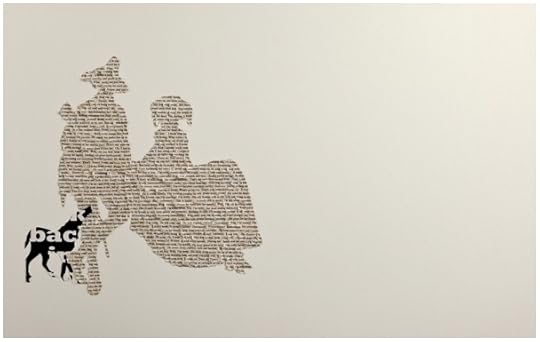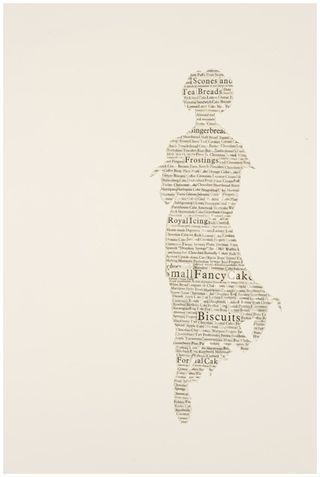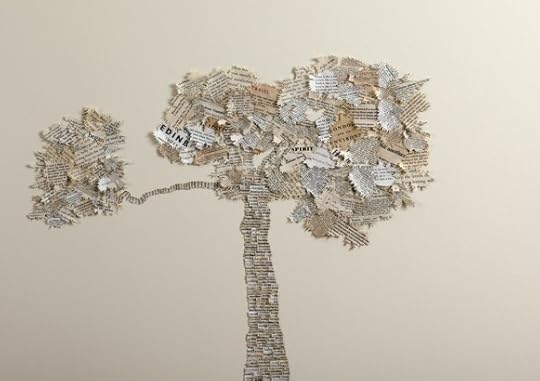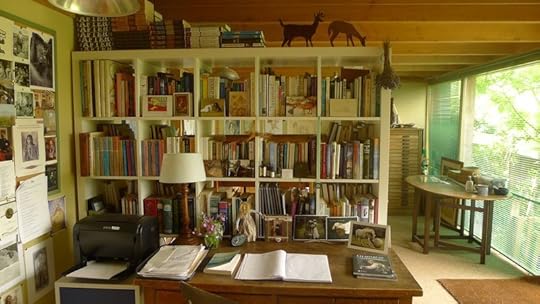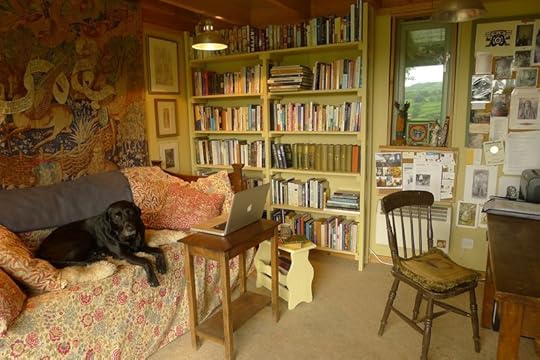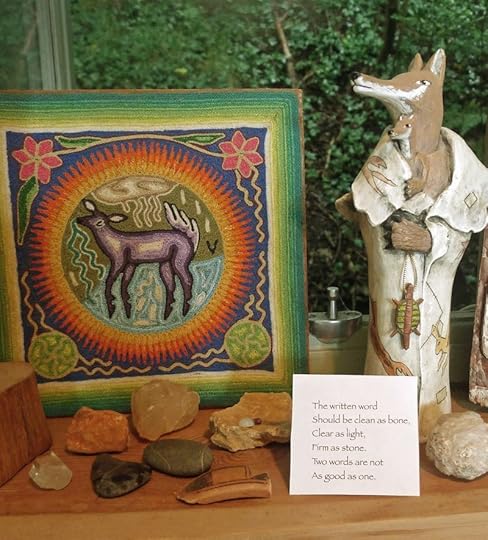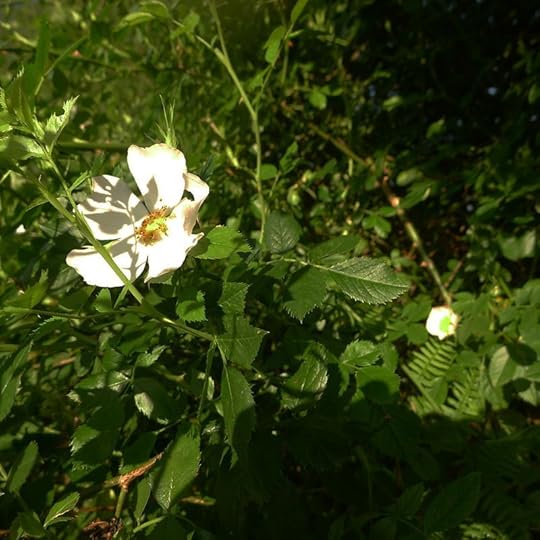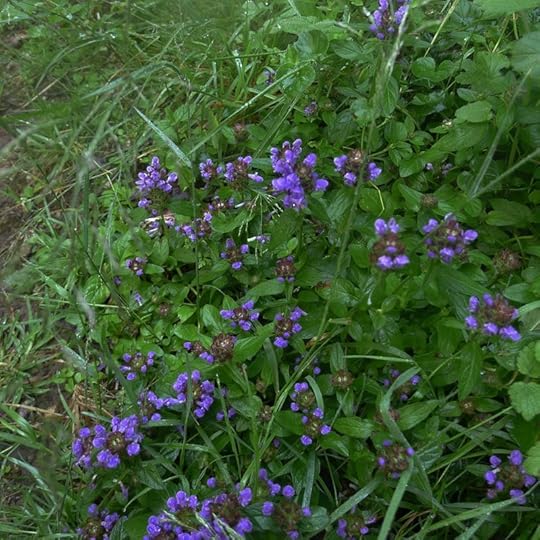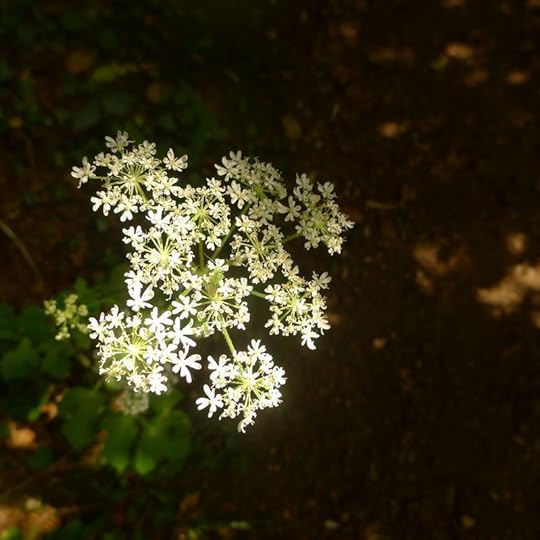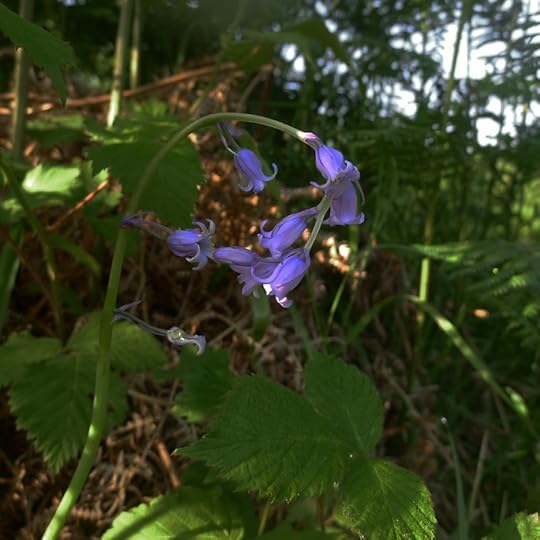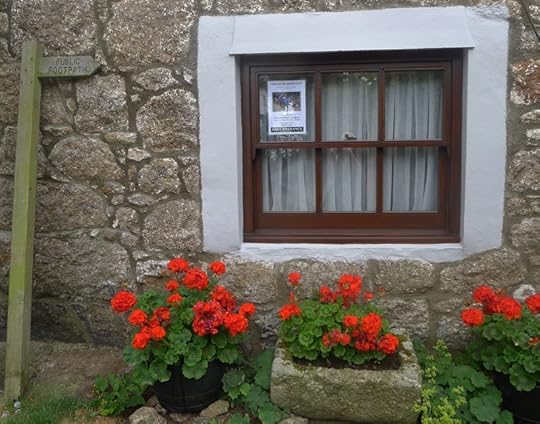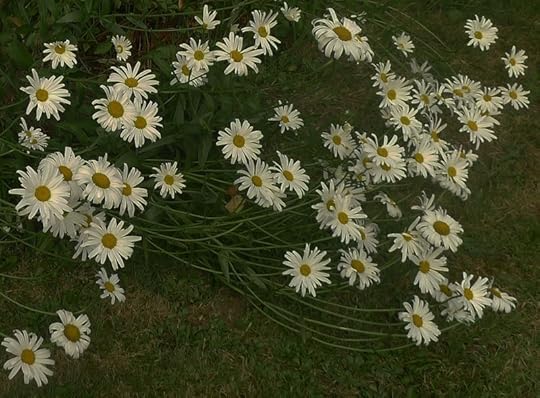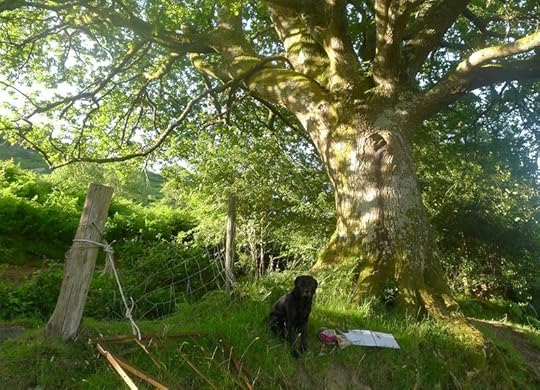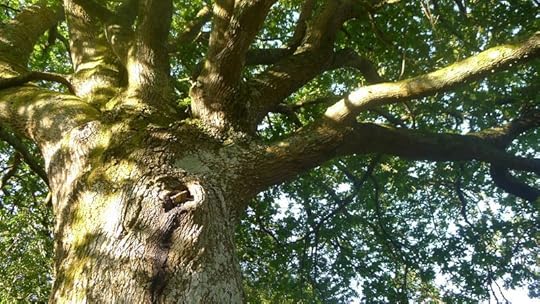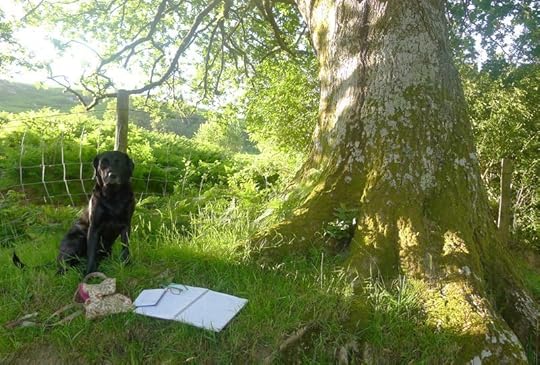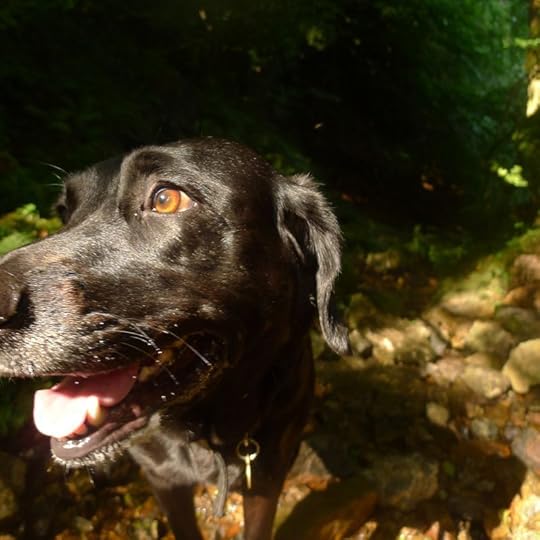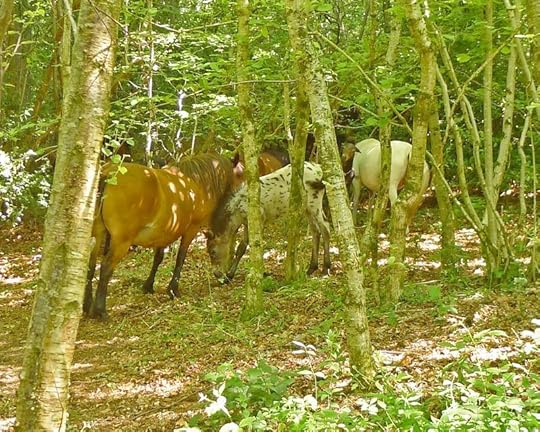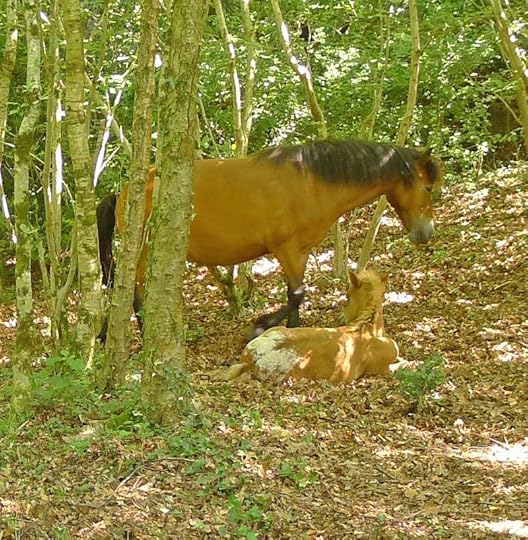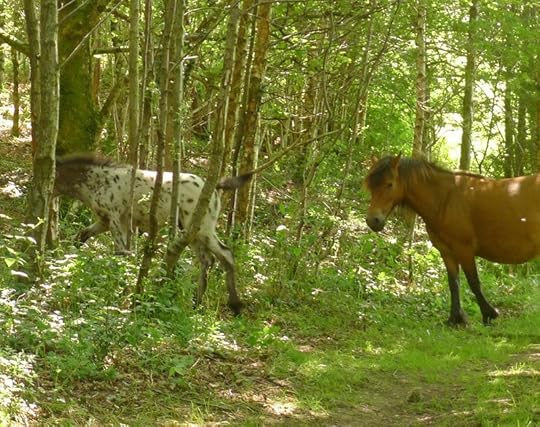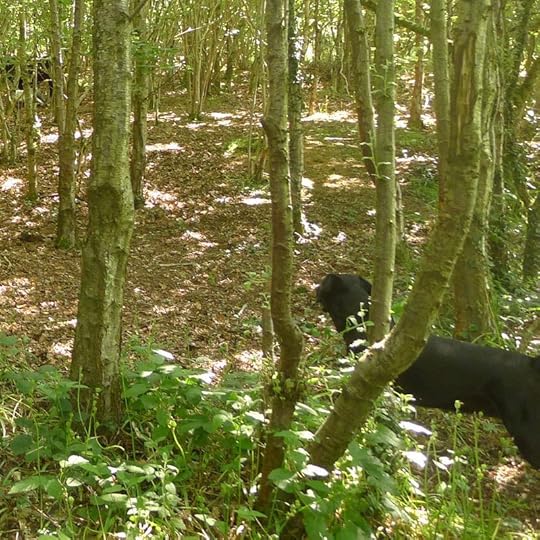Terri Windling's Blog, page 159
August 5, 2014
The power of words (part II)
Be careful of words,
even the miraculous ones.
For the miraculous we do our best,
sometimes they swarm like insects
and leave not a sting but a kiss.
They can be as good as fingers.
They can be as trusty as the rock
you stick your bottom on.
But they can be both daisies and bruises.
Yet I am in love with words.
They are doves falling out of the ceiling.
They are six holy oranges sitting in my lap.
They are the trees, the legs of summer,
and the sun, its passionate face.
Yet often they fail me.
I have so much I want to say,
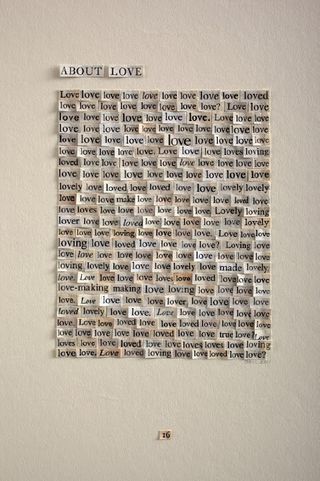 so many stories, images, proverbs, etc.
so many stories, images, proverbs, etc.
But the words aren't good enough,
the wrong ones kiss me.
Sometimes I fly like an eagle
but with the wings of a wren.
But I try to take care
and be gentle to them. Words and eggs must be handled with care.
Once broken they are impossible
things to repair.
- Anne Sexton (The Complete Poems)
"I wanted to crawl in between those black lines of print the way you crawl through a fence and go to sleep under that beautiful big green fig-tree."
- Sylvia Plath (The Bell Jar)
"She entered the story knowing she would emerge from it feeling she had been immersed in the lives of others, in plots that stretched back twenty years, her body full of sentences and moments, as if awaking from sleep with a heaviness caused by unremembered dreams."
- Michael Ondaatje (The English Patient)
"In the end, it is my belief, words are the only things that can construct a world that makes sense."
- Kate Atkinson (Behind the Scenes at the Museum)
The images here are by Ellen Bell, an artist and writer based in Wales.
"I work directly with books, texts and paper ephemera to create drawings, installations and sculptures that pose questions rather than deliver answers about how we communicate within our familial and intimate relationships," she says. "The physicality of the books, the printed surface of the page and the design of the texts play an important role in the making of my work, as does the serendipity involved in the ‘finding’ of them – the musty smell, the grainy texture of the paper, the inconsistent heaviness of some of the type and the dated graphics of the book covers all play their part in seducing me into working with them."
 "Words" by Anne Sexton was published in The Complete Poems, 1981; all rights reserved by the author's estate.
"Words" by Anne Sexton was published in The Complete Poems, 1981; all rights reserved by the author's estate.
The power of words
"To be read. To be heard. To be seen. I want to be read, I want to be heard. I don't need to be seen. To write requires an ego, a belief that what you say matters. Writing also requires an aching curiosity leading you to discover, uncover, what is gnawing at your bones. Words have a weight to them. How you choose to present them and to whom is a matter of style and choice."
- Terry Tempest Williams (When Women Were Birds: Fifty-four Variations on Voice)

"Words are pale shadows of forgotten names. As names have power, words have power. Words can light fires in the minds of men. Words can wring tears from the hardest hearts."
- Patrick Rothfuss (The Name of the Wind)
"If you say a word, it leaps out and becomes the truth. I love you. I believe it. I believe I am loveable. How can something as fragile as a word build a whole world?"
- Franny Billingsley (Chime)
''I know nothing in the world that has as much power as a word. Sometimes I write one, and I look at it, until it begins to shine.'' - Emily Dickinson
August 4, 2014
Tunes for a Monday Morning
Starting the week with the music of three Scottish women...
In the video above, Alyth McCormack and her band perform Suzanne Vegas' gorgeous song "The Queen and the Soldier." The video below features more traditional Scottish fare in "The Vices Set." McCormack comes from the the Isle of Lewis in Scotland's Outer Hebrides.
Next:
Scottish harpists Mary Macmaster and Corrina Hewat join Alyth McCormack to sing "Flowers Grow" in a video recorded last December.
Last:
Macmaster/Hay (harpist Mary McMaster and percussionist Donald Hay) perform "Hook" at the Edinburgh Harp Festival. Macmaster, from Glasgow, is also a member of the harp duo Sileas (with Patsy Seddon) and of the all-women band The Poozies.
July 31, 2014
Living by stories
From Ben Okri's A Way of Being Free:
"In a fractured age, when cynicism is god, here is a possible heresy: we live by stories, we also live in them.
"One way or another we are living the stories planted in us early or along the way, we are also living the stories we planted - knowingly or unknowingly - in ourselves. We live the stories that either give our lives meaning, or negate it with meaninglessness. If we change the stories we live by, quite possibly we change our lives."
“What hope is there for individual reality or authenticity when the forces of violence and orthodoxy, the earthly powers of guns and bombs and manipulated public opinion make it impossible for us to be authentic and fulfilled human beings?
"The only hope is in the creation of alternative values, alternative realities. The only hope is in daring to redream one's place in the world -- a beautiful act of imagination, and a sustained act of self becoming. Which is to say that in some way or another we breach and confound the accepted frontiers of things."
'The highest kind of writing -- which must not be confused with the most ambitious kind -- belongs to the realm of grace. Talent is part of it, certainly; a thorough understanding of the secret laws, absolutely. But finding the subject and theme which is in perfect harmony with your deepest nature, your forgotten selves, your hidden dreams, and the full unresonated essence of your life -- now that cannot be reached through searching, nor can it be stumbled upon through ambition. That sort of serendipity comes upon you on a lucky day. It may emerge even out of misfortune or defeat. You may happen upon it without realising that this is the work through which your whole life will sing. We should always be ready. We should always be humble. Creativity should always be a form of prayer.”
July 30, 2014
Tangles and threads
From Eudora Welty's On Writing:
"Writing fiction has developed in me an abiding respect for the unknown in a human lifetime and a sense of where to look for the threads, how to follow, how to connect, find in the thick of the tangle what clear line persists.
“Both reading and writing are experiences -- lifelong -- in the course of which we who encounter words used in certain ways are persuaded by them to be brought mind and heart within the presence, the power, of the imagination."

"We do need to bring to our writing, over and over again, all the abundance we possess. To be able, to be ready, to enter into the minds and hearts of our own people, all of them, to comprehend them (us) and then to make characters and plots in stories that in honesty and with honesty reveal them (ourselves) to us, in whatever situation we live through in our own times: this is the continuing job, and it's no harder now than it ever was, I suppose. Every writer, like everybody else, thinks he's living through the crisis of the ages. To write honestly and with all our powers is the least we can do, and the most."
The images here are by the Japanese installation artist Machiko Agano. Born in Kobe and trained as a weaver at the Kyoto City University of Arts, she hand weaves her site-specific sculptures using a wide range of materials, including silk, bamboo, and fishing wire.
"I am attracted by the mysterious shapes of nature," she says, "patterns made by the wind on desert sands; shapes of eroded rocks on coastal shores; clouds driven scross the autumn sky. This is my art: the exploration and expression of the fundamentals of nature."
July 29, 2014
The spaces we create with words
"A kind of writing solely meant for a public forum," said Harold Brodkey, "is often less interesting than writing where the writer has invented the public space inside the text, in the tone of address, in the tone of the language -- where the address is new and as if in private. Public language is never new. But in good writing there is something absolutely new in the tone. There’s a very complicated idea that lies behind the notion of the public space in which the narrator addresses the reader. It’s an idea that has to do with language being actual, being temporal and spatial, to be Kantian about it. In a piece of writing the language runs along on the page and in the mind of a reader; in that language is no actual physical space, but it should carry the implication of a physical-social location.
"If you’ve been to a large Edwardian house," Brodkey continues, "you may have seen a small room with a fireplace and a couch, and perhaps two chairs -- not a formal, large room where you can carry on, but one where you can sit and talk. It’s where you gossip. Henry James has a tone of address as if he’s arrived at such a large house, not his own, and he is seated by the fire; an invisible interlocutor or audience listens closely. Walt Whitman speaks outdoors it seems to me. The space Whitman suggests is complex and American and I think beautiful and a completely new invention. One thing that is unique about it is that there’s no tinge of social class in it whatsoever.
"Jane Austen’s writing suggests a drawing room sort of space; Hemingway’s, on a bar stool or in a club car -- it changes, he’s complicated. Emily Dickinson creates a marvelous public space, too, and one of the marvelous things about it is that it is so clearly an invention since it isn’t based on being public; it is without a sense of the public. D. H. Lawrence is an absolutely amazing writer, with a fantastic sense of the language, but his sense of public space wavers, and sometimes a whole book or long story of his will collapse when he shifts the public space thing too drastically and is churchly-fascistic, or starts yelling as if in a corral, then muttering in a hallway . . . No order in it at all."
I want to create a public space in my writing that looks something like this: sun-dappled grass beneath a fairy tale oak...with a flash of modern steel running behind it.
Or else one consisting of mis-matched chairs gathered 'round the kitchen table in an old country house, the pearly light of dawn streaming in, coffee freshly poured, and a black dog dozing by the hearth.
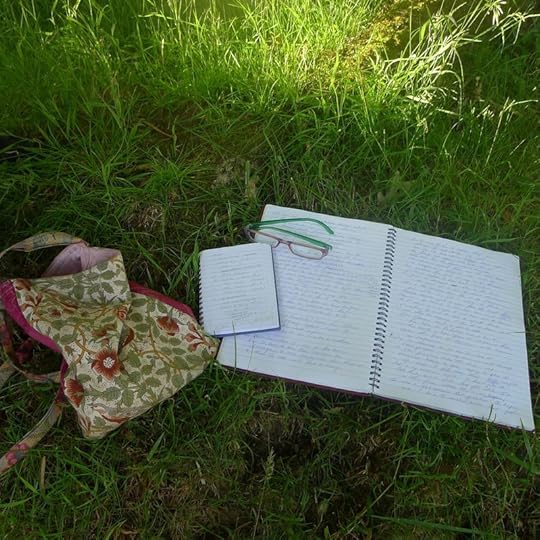
What would you like the public space created by your writing or art to look like...?
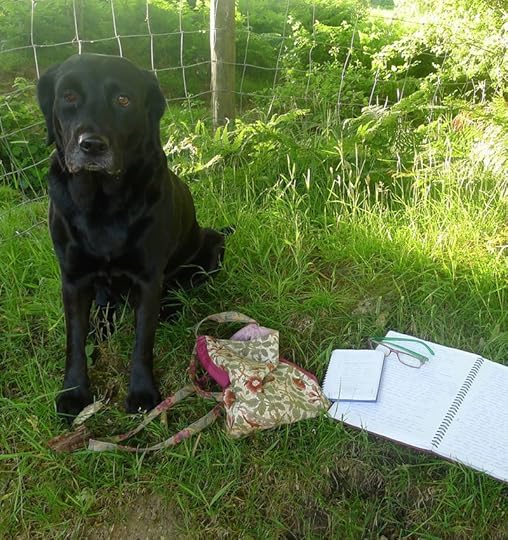
July 28, 2014
What places make of us
After finishing Olivia Laing's To the River, in which the author walks the River Ouse from its source to the sea, my next re-reading project is to revisit two of my favorite books about walking -- Wanderlust by Rebecca Solnit and The Old Ways by Robert Macfarlane -- before moving on to another first-time read: A Philosophy of Walking by Frédéric Gros.
What better time of year could there be for walkers' tales of holloways, hedgerows, green roads, ghost roads, pilgrim ways and nights under the stars? Every time I ramble through the woods with Tilly my feet want to carry me on and further on, the flag of her tail waving jauntily ahead...until I catch myself succumbing to the "rapture of the pathway," stop, give a whistle, and turn for home; work must be done and life attended to, as the clocks tick tock, and the telephone rings, and nevermind how sweetly the sun filters through the trees, nevermind, nevermind. Come along, dear girl. We must away.
But in my imagination, we don't turn back, we keep on climbing through ash, old oak, thickets of holly, tall stands of pine, while the little woodland grows large around us, becoming a proper forest now, and the trail and the tale wind on and the tree tops shiver and the story begins:
Once upon a time....
"I have long been fascinated," writes Robert Macfarlane, "by how people understand themselves using landscape, by the topographies of self we carry within us and by the maps we make with which to navigate these interior terrains. We think in metaphors drawn from place, and sometimes those metaphors do not only adorn our thoughts, but actively produce it. Landscape, to borrow George Eliot's phrase, can 'enlarge the imagined range for self to move in.'
"As I envisage it, landscape projects into us not like a jetty or peninsula, finite and bounded by its volume and reach, but instead as a kind of sunlight, flickeringly unmappable in its plays yet often quickening and illuminating. We are adept, if occasionally embarrassed, at saying what we make of places -- but we are far less good at saying what places make of us.
"For some time now it has seemed to me that the two questions we should ask of any strong landscape are these: firstly, what do I know when I am in this place that I can know nowhere else? and then, vainly, what does this place know of me that I cannot know of myself?"
Yes, those are, indeed, the right questions....but I'm troubled by Macfarlane's use of the word "vainly." What precisely can he mean by this? That the question is a narcissistic one, with its assumption that the land gives a toss about us? Or that it's a question asked in vain, to which we will never have an answer?
It's my belief that the second question can be answered, for it is possible to have a conversation with the landscape and to hear (at least to the degree we are capable of hearing) what the land around us has to say. Art is one time-honored way to facilitate such a dialogue; another, used by animist cultures around the globe, is through sacred rituals specifically designed to mediate between the human and nonuman worlds. The conversation requires a relationship with the landscape...and patience, time, the ability to truly listen, and a certain humility...but there's nothing extraordinary or supernatural about it. Young children talk to the land instinctively. It's only as adults that we forget.
"Tell me the landscape in which you live," said the Spanish philosopher José Ortega y Gasset, "and I'll tell you who you are."
His quote is written in gold on my studio wall, for it sums up everything I write and paint.
July 27, 2014
Tunes for a Monday Morning
With so much conflict and sorrow in the world right now, I'm going to start the week with the heart-centred music of Mali, which has a very long tradition of using songs and musical rhythms in support of physical, spiritual, and cultural healing.
Above: "kakKar," peformed by the great Boubacar Traoré, from Kayes in western Mali. His songwriting is rooted in the traditional music of the Mande cultural region mixed with influences ranging from Arab music to American blues.
Below: "Wassiye," performed by Habib Koité (and his band, Bamada), who comes from a long line of Khassonké griots in western Mali. He grew up listening to his paternal grandfather play the kamele n’goni, a traditional four-stringed instrument, and developed his distinctive guitar style (tuned to a pentatonic scale and played on open strings, like the kamale n'goni) while accompanying his griot mother.
Above, "Tinki Hiiri" performed by Afel Bocoum (and his band, Alkibar), who comes from Niafunké, on the Niger River in central Mali. Bocoum, of the Sonrai people, grew up with the se galarare style of traditional music, which he learn from his father, a performer of the njarka and njurkel (single and double stringed instruments). At only 13, Bocoum went on tour with his uncle, the legendary Ali Farka Toure, playing in his uncle's band for ten years before striking out on his own. Bocoum sings primarily in Sonrai, his native language, but also in Tamasheq (the language of the Tuareg) and in Fulfulde (the language of the Fula people).
Below: a gorgeous song in which 40 musicians from different parts of Mali, and different ethnic cultures, join together in a call for peace. The musicians involved include Amadou & Mariam, Oumou Sangare, Bassekou Kouyate, Vieux Farka Toure, Djelimady Tounkara, Toumani Diabate, Khaira Arby, Kasse Mady Diabate, Baba Salah, Tiken Jah, Amkoullel, Habib Koité, and Afel Bocoum. The project was created by Fatoumata Diawara, a singer/songwriter who blends the Wassalou traditions of southern Mali with jazz, soul, and other international influences. Diawara was born in Ivory Coast, spent her youth in Bamako (Mali's capital city), and now lives in France.
Go here to read about griots in modern Mali, and here to read about the threat to this tradition in Islamist areas where music has been banned.
And last: East meets west in "Chamber Music" by Malian kora player Ballaké Sissoko and French cellist Vincent Ségal (of Bumcello). Sissoko is the son of the great kora player Djelimady Sissoko, and, like most musicians from the griot caste, began playing and performing at a very young age. He comes from Bamako in western Mali. Vincent Ségal comes from Reims.
In addition to the musicians mentioned above I also recommend Yaya Diallo, Toumani & Sidiki Diabaté (father & son kora players), Bassekou Kouyate, Kokanka Sata, and the Tuareg music of Tinariwen and Tartit -- though there's so much good music coming out of Mali that it's impossible to list it all.
July 25, 2014
Five years old today....
She was eight weeks old on the day we brought home, which feels like yesterday...and yet it also seems like we've never been without her.
July 24, 2014
The capacity for awe
From Dani Shapiro's Still Writing: The Pleasures and Perils of a Creative Life:
"Too often, our capacity for awe is buried beneath layers of perfectly reasonable excuses. We feel we must protect ourselves -- from hurt, disappointment, insult, loss, grief -- like warriors girding for battle. A Sabbath prayer I have carried with me for more than half my life begins like this: 'Days pass and the years vanish and we walk sightless among miracles.'
"We cannot afford to walk sightless among miracles. Nor can we protect ourselves from suffering. [As writers] we do work that thrusts us into the pulsing heart of the world, whether or not we're in the mood, whether or not it's difficult or paintful or we'd prefer to avert our eyes. When I think of the wisest people I know, they share one defining trait: curiosity. They turn away from the minutiae of their lives -- and focus on the world around them. They are motivated by a desire to explore the unfamiliar. They enjoy surprise."
From Paul Bogard's The End of Night: Searching for Natural Darkness in an Age of Artificial Light:
''Most days I live awed by the world we have still, rather than mourning the worlds we have lost. The bandit mask of a cedar waxwing on a bare branch a few feet away; the clear bright sun of a frozen winter noon; the rise of Orion in the eastern evening sky - every day, every night, I give thanks for another chance to notice. I see beauty everywhere; so much beauty I often speak it aloud. So much beauty I often laugh, and my day is made.
''Still if you wanted to, I think, you could feel sadness without end. I’m not even talking about hungry children or domestic violence or endless wars between supposedly grown men...but ‘you mustn’t be frightened if a sadness rises in front of you, larger than any you even seen,' said Rilke, 'you must realize that something is happening to you, that life has not forgotten you, that it holds you in it hand and will not let you fall.' ''
After five years on the flanks of Nattadon Hill, it is deeply familiar, and eternally surprising. Tilly and I never know what we might find: tall spires of foxglove flaming among the trees, badger prints pressed into the mud beside the leat, or a herd of wild ponies resting in the shade at the woodland's edge. Every day there are wonders, large and small. If I stayed inside intent on screen and keyboard, how would I see them? And if I numbed myself against sorrow and despair, how would I feel awe and joy?
Come, says Tilly, it's time to go out again, and she's always right. The world calls us, in all its dark and bright and sun-dappled shade. Full of hardship, yes, but also moments of magic: a quiet, daily, domestic kind of magic. A bright summer day, and a good dog at your side, and wild ponies in the woods.
Terri Windling's Blog
- Terri Windling's profile
- 708 followers


